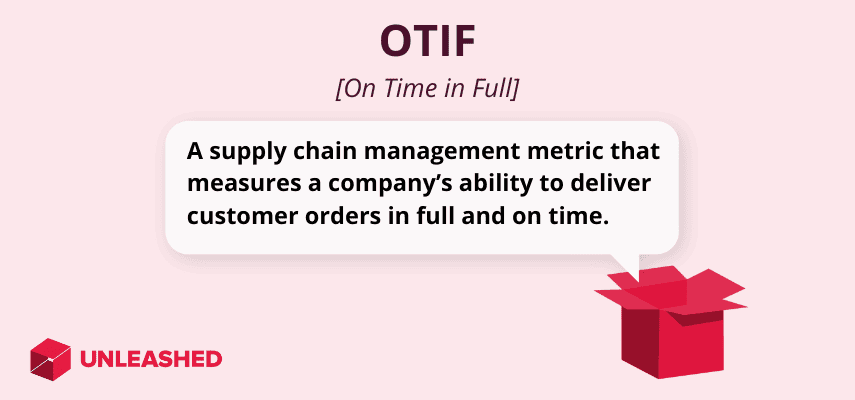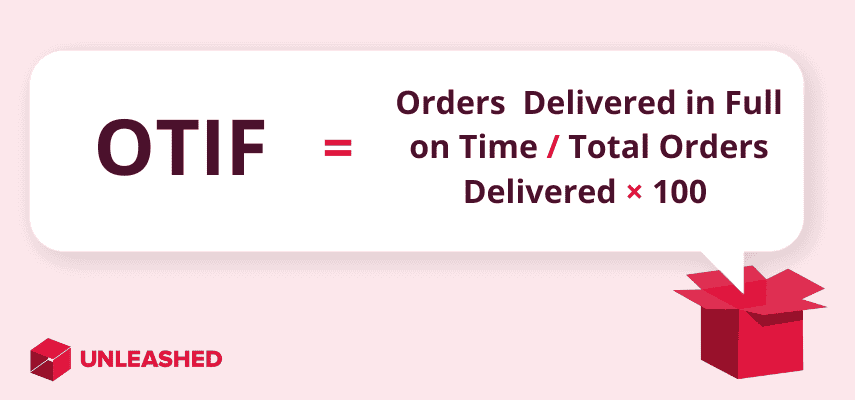
Today, customers expect quick and accurate deliveries from vendors. And if you’re ordering goods for your business, you probably expect the same from yours.
To measure how effective a company is at delivering complete orders on time, you can use the aptly named On Time in Full (OTIF) metric. This article explains what it is, how to measure and improve it, and how to improve your OTIF rate.
What is On Time in Full? OTIF meaning
On Time in Full (OTIF) is a supply chain management metric that tracks a supplier's ability to meet delivery promises. It does so by measuring the efficiency and accuracy of order fulfilment to identify the percentage of orders delivered to the correct place – with the correct items in the right quantity – at the agreed-upon time.
OTIF is an important KPI because it directly impacts customer satisfaction and trust in supply chain partnerships. Achieving high OTIF rates indicates an efficient and reliable supply chain operation, which leads to happier customers and healthier business relationships.
OTIF and Delivery in Full on Time (DIFOT) are interchangeable terms. Either metric may be used to help you minimise delays and errors in your delivery process.

OTIF vs OTD
On Time Delivery (OTD) and OTIF are both order fulfilment metrics. However, OTIF measures the delivery performance of complete orders shipped on time, whereas OTD focuses solely on the timeliness of deliveries, regardless of order completeness.
For example, let’s say you report an OTIF rate of 95%. This indicates that 95% of your orders were delivered on time and with all items in the order complete.
At the same time, your OTD rate might be reported at 98%. This means that 98% of all orders were delivered by the agreed date, but not necessarily with the complete order. This can happen when you prioritise shipping dates over order completeness or speed over accuracy.
OTIF and OTD provide valuable insights into different aspects of your delivery process. Both are useful for assessing the efficiency and reliability of your supply chain.
Fill rate vs OTIF
Fill rate is another metric that measures the efficiency and effectiveness of your order fulfilment.
Unlike OTIF or OTD, your fill rate represents the percentage of customer demand that is met from your on-hand stock, without backorders or lost sales. It measures inventory availability and the ability to meet customer orders as they come in.
OTIF, in contrast, measures the proportion of orders delivered to the customer's satisfaction (in terms of the order being completed and delivered on time). OTIF encompasses both the logistical efficiency of getting products to customers when they expect them and the accuracy of order fulfilment.
Why is OTIF an important supply chain management metric?
OTIF helps businesses in the supply chain measure their suppliers’ reliability. But it can also be used to measure your own reliability – from the customer’s perspective.
Below are 10 key aspects of supply chain management that can be improved by tracking your OTIF rate.
1. Customer satisfaction
A high OTIF rate has a positive effect on your customers’ satisfaction because it ensures they receive their orders as expected, which is crucial for maintaining consumer trust and loyalty.
Timely deliveries of a complete order without any missing items will significantly enhance your customer’s experience, leading to repeat business and positive word-of-mouth.
2. Inventory management
A business with a healthy OTIF score is more likely to manage its inventory well and avoid overstocking or stockouts. A high OTIF rate also indicates that orders are being fulfilled as expected, which can lead to reduced inventory levels because there is less need for safety stock.
Conversely, a low OTIF rate may force you to maintain higher inventory levels to compensate for uncertainties in supply. This results in increased holding costs and a greater risk of inventory obsolescence. Maintaining a high OTIF rate is therefore essential for optimising your inventory and minimising your inventory costs.
3. Vendor performance
OTIF can be used to assess vendor performance. Vendors that consistently meet OTIF targets are typically more reliable and understand the importance of deadlines.
A high OTIF rate indicates that your vendor is consistently delivering orders on time and in the correct quantity. This leads to stronger supplier relationships, increased customer satisfaction, and the potential for more business opportunities.
Equally, a low OTIF rate can signal potential issues in your vendor's supply chain processes, such as production delays or inventory shortages, which can negatively impact their reputation, and your ability to deliver OTIF or DIFOT.
4. Cost reduction
An improved OTIF rate offers significant cost reductions for your business.
The fewer late shipments you have means you spend less money on expedited shipping costs and returns management. It also reduces your inventory holding costs by ensuring that goods are not sitting idle in your warehouse for too long.
Additionally, high OTIF delivery prevents stockouts and the associated lost sales and customer dissatisfaction, which may lead to additional customer service costs and future lost revenue.
5. Supply chain visibility
Focusing on your OTIF metric allows you to identify bottlenecks and improve delivery processes.
When your orders are being delivered on time and in the correct quantity, it enhances supply chain visibility by providing you with real-time data on the flow of goods. This visibility allows you to predict possible delays and improve overall operational efficiency.
A low OTIF rate can signal issues within your supply chain that need to be addressed to ensure timely and complete deliveries.

6. Forecasting accuracy
The impact of OTIF on forecast accuracy is crucial for optimal planning and resource allocation.
High OTIF rates generally indicate a reliable supply chain, which in turn suggests that forecasting systems are accurately predicting demand and inventory requirements. Conversely, low OTIF rates may signal issues with inventory management or demand planning – leading to inaccurate forecasts.
7. Competitive advantage
Companies with high OTIF rates may gain a competitive advantage as they’re seen by customers to be more reliable. By consistently meeting delivery commitments, you can improve customer satisfaction and brand reputation.
A company known for reliability and trustworthiness can attain a stronger market position. Furthermore, efficient OTIF performance fosters better inventory management, reducing your total costs and freeing up capital for other strategic investments.
8. Waste reduction
OTIF reflects the likelihood of overproduction and excess inventory. Better OTIF rates can therefore lead to waste reduction in your supply chain, as products are less likely to be damaged or become obsolete.
Additionally, accurate fulfilment reduces the need for expedited shipping and handling. This cuts down on operational costs and lessens the environmental impact associated with transportation.
Thus, OTIF plays a significant role in waste reduction by streamlining supply chain processes and promoting sustainable practices.
9. Regulatory compliance
In some industries, meeting OTIF benchmarks is a regulatory requirement. That makes it essential for legal compliance and ensuring adherence to industry regulations and standards.
OTIF directly impacts regulatory compliance because it reveals your company's ability to meet its contractual obligations. When OTIF rates are high, it indicates that your business is reliable and consistent in its operations, which can lead to positive assessments from regulatory bodies.
Low OTIF rates, on the other hand, may signify potential compliance issues – such as delays in delivering goods or services – which could result in penalties or fines.
10. Market responsiveness
A high OTIF score means your business can respond quickly to market changes, maintaining customer trust even in volatile conditions. This reliability can lead to increased customer loyalty and repeat business.
Efficient OTIF performance can improve a company's reputation in the market, making it more competitive and able to respond quickly to market demands and changes. Whereas a low OTIF rate could harm your company's market responsiveness by eroding customer trust and leading to lost sales opportunities.
How to measure OTIF
To measure OTIF, you need to track two main components: on-time delivery rate and in-full delivery rate.
Your on-time delivery rate is the percentage of orders delivered by the promised date. The in-full delivery rate measures the percentage of orders that are delivered with the correct quantity and specifications. To calculate OTIF, multiply these two percentages together.
OTIF formula
The OTIF formula calculates the percentage of orders delivered on time and in the full quantity that was ordered.
The formula for calculating your OTIF rate is:
Total Orders Delivered on Time and in Full / Total Orders Delivered × 100 = OTIF Rate
The higher your OTIF score, the more efficient and reliable your supply chain performance.

OTIF calculation example
Let’s look at a quick example of how the OTIF formula is used in business.
If a coffee roaster receives 600 orders and 455 are delivered on time and in full, the OTIF rate would be calculated as follows:
455 / 600 × 100 = 75.8
In this example, the OTIF is 75.8% which indicates the coffee roaster needs to identify areas for improvement in their order fulfilment and delivery process.
Factors impacting time On Time in Full rate
Key factors impacting the time it takes your organisation to achieve OTIF include:
- Resource availability
- Workforce efficiency
- Project complexity
- Stakeholder involvement
- External variables such as market conditions or regulatory changes
- Inventory optimisation
- Forecasting accuracy
- Efficiency of operational processes
Efficient time management and proactive planning are crucial in mitigating these factors to ensure timely completion of objectives.
To deliver OTIF effectively, you should focus on improving end-to-end visibility in your supply chains and ensure accurate real-time data is available to predict and address potential delays proactively.
Aligning internal definitions of 'on-time' and 'in-full' across different departments and with external partners is also crucial to standardise measurements and expectations.
A survey conducted by McKinsey and the Trading Partner Alliance suggests that a standardised definition of OTIF would help streamline processes by setting clear expectations for all parties involved. A uniform OTIF standard would foster collaboration among trading partners, because they would be operating under a shared set of criteria, minimising misunderstandings and disputes related to delivery metrics.
Such collaboration could be key to resolving supply issues swiftly and effectively. In turn, the overall efficiency of the supply chain may improve.
Ultimately, a well-defined and universally accepted OTIF standard could lead to a more synchronised and resilient supply chain ecosystem.

How to improve OTIF
To improve your OTIF performance, follow these best-practice tips:
- Optimise demand forecasting. Enhance forecast accuracy by analysing past performance data and market trends. For example, a retailer could use predictive analytics to better anticipate seasonal demand spikes.
- Lift operational efficiency. Streamline warehouse operations with automated sorting systems – such as conveyors, barcode scanners, and diverters – that work in unison to route items quickly and accurately to their destinations reducing the time goods spend in transit.
- Establish healthy vendor relationships. Strengthen supplier relationships to ensure material availability and improve supply chain visibility. Setting up regular communication channels with key suppliers can mean you receive updates on potential delays and develop contingency plans for disruptions.
- Utilise technology for tracking order status. Implement real-time tracking systems for visibility into shipment status. Optimising transportation routes using advanced routing software can also contribute to timely deliveries and enable proactive adjustments.
- Train staff on the importance of OTIF and its impact on customer satisfaction. By establishing clear accountability within teams, employees understand their role in achieving OTIF goals. Fostering a culture of urgency and precision ensures that every team member strives to meet deadlines with accuracy.
- Develop inventory optimisation processes. Strategies like just-in-time inventory management can help by streamlining supply chains and reducing transit times. Synchronising the production schedule directly with customer demand means you can minimise inventory levels and reduce the time it takes for products to reach your customers.
- Regularly review your OTIF performance metrics to find areas for improvement. Ensure that logistics strategies are continually refined to meet customer demands effectively. By analysing OTIF data, you can identify trends, and adjust strategies to maintain high levels of customer satisfaction and operational efficiency.
These approaches, supported by digital transformation across the supply chain, can drive significant improvements in meeting OTIF objectives.
More posts like this:
